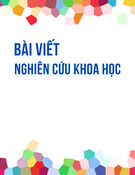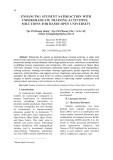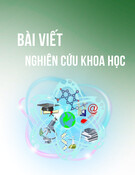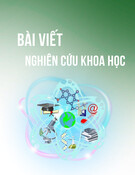
33
HNUE JOURNAL OF SCIENCE
Educational Sciences 2024, Volume 69, Issue 3, pp. 33-43
This paper is available online at https://hnuejs.edu.vn
DOI: 10.18173/2354-1075.2024-0144
EFL TERTIARY STUDENTS’ PERCEPTIONS OF LEARNER AUTONOMY IN THE
OUT-OF-CLASS LEARNING CONTEXT: SITUATIONS AND DISCUSSIONS
Le Ha To Quyen1*, Dang Tan Tin 2, and Bui Thi Thuc Quyen3
1Faculty of Foreign Languages, Saigon University, Ho Chi Minh City, Vietnam
2 Faculty of Foreign Languages, HCMC University of Technology and Education,
Ho Chi Minh City, Vietnam
3 Faculty of Foreign Languages, Ho Chi Minh City Open University, Ho Chi Minh City, Vietnam
*Corresponding author: Le Ha To Quyen, e-mail: lhtquyen@sgu.edu.vn
Received January 19, 2024. Revised April 20, 2024. Accepted April 27, 2024.
Abstract. Learner autonomy has been one of the central aims of education because of its
significant role in lifelong learning. With the advancement of technology and the abundance
of learning resources, students have many opportunities for learner autonomy development
outside the classroom. However, the out-of-class learning context is under-explored in the
Vietnamese context, and research about fostering learner autonomy in this context is also
minimal. The current study aims to explore EFL tertiary students’ learner autonomy in the
out-of-class learning context, filling this gap. The results of answers from 709 English majors
in different universities in Ho Chi Minh City showed that students had average control in
three dimensions of learner autonomy: situational, behavioral, and psychological. Even
though students are averagely psychologically ready for independent study, they still lack
autonomous learning strategies. Implications are then made for educators to guarantee the
possibility of promoting learner autonomy in out-of-class learning.
Keywords: learner autonomy, out-of-class learning, EFL tertiary education.
1. Introduction
Tertiary education is a valuable period for students to be nurtured, supported, and matured
in knowledge and generic skills. Even though tertiary students have learned English for many
years with the assistance of affluent learning resources, their language learning outcomes are not
very promising. Many, including English majors, fail to achieve the required language level to
graduate [1]. Graduates also face mounting criticism from employers about their English
competence when they join the workforce [2].
Many reforms have been taken to enhance learning outcomes of English teaching and
learning at the tertiary level, in which the solutions that target the students' control in learning,
leading to improvements in their English, should be the focus [3]. The importance of being
independent in learning and getting ready for lifelong learning has given rise to the need to
promote learner autonomy for this specific group of students.
Learner autonomy was typically considered a Western construct, which is difficult for
Vietnamese students to fully master due to the strong influences of Confucian cultural features
[4]. Despite these cultural factors, supporting learner autonomy has received more concerns in

Le HTQ*, Dang TT & Bui QTT
34
the Vietnam education system in recent years. From the policy level, the regulations require that
any training program’s learning outcomes clearly define a graduate’s degree of autonomy besides
the requirements for knowledge, skills, and accountability [5]. Despite these efforts, Vietnamese
tertiary students still exhibited low and reactive learner autonomy [6], [7], indicating the need to
foster actions. Out-of-class learning is the context suitable for developing learner autonomy
because students are supposed to be in charge of their learning. However, this learning context is
under research in the Vietnamese context. As a result, the problem that persists is the inadequate
discussion and understanding of EFL tertiary students’ learner autonomy in out-of-class learning.
The current research investigates English majors’ level of control when learning outside the
classroom, which can provide implications to promote students’ learner autonomy in the out-of-
class learning context.
2. Content
2.1. Literature review
2.1.1. Definition
Learner autonomy has been one of the foci in educational practices and research for over
four decades [8]. Learner autonomy in foreign/ second language learning is widely recognized as
a complicated [9], complex and multifaceted construct [10].
Holec, the father of language learner autonomy, defined learner autonomy as “the ability to
take charge of one’s learning” [11] (p. 3). An autonomous learner can “determine the learning
objectives, define the contents and the progressions, select methods and techniques to be used,
monitor the procedure of acquisition (rhythm, time, place...), and evaluate what has been
acquired” [11] (p. 3). Benson substituted the terms “ability” and “take charge” with “capacity”
and “control”, respectively, to define learner autonomy as “the capacity to take control of one’s
learning” (p. 47). He suggests that learners will actively self-direct their learning if they have the
ability and the desire to control their learning and if learning materials and social and
psychological constraints do not hinder them. The term “capacity” compiling “ability, desire, and
freedom” has become the overarching concept to depict the individual learner taking control of
their learning [12] (p.47).
In the context of this study, Benson’s definition of learner autonomy, highlighting learner
autonomy as the capacity of learners to take control of their learning, is aptly chosen [13]. This
conceptualization resonates with the out-of-class learning context where learners exhibit their
ability and are mentally ready to learn independently. Furthermore, learners manage their learning
processes effectively, underscoring how they navigate their freedom outside the classroom.
2.1.2. Dimensions of learner autonomy
Benson’s framework of three dimensions of control – situational, behavioral, and
psychological – can depict students’ learning, especially in the context of out-of-class learning
when the learners need to control not only their learning behaviors but also the learning situations
and psychology of learning [13]. It is the reason for the selection of this model in this research.
2.1.2.1. Situational dimension
Benson states that “the learners should freely determine the content of learning” and that
autonomous learners should “have the freedom to determine their own goals and purposes if the
learning is to be genuinely self-directed” (p. 49), considering the learning context where certain
constraints (such as curriculum) usually exist. The control of the situational dimension, therefore,
indicates the empowerment or emancipation of learners by giving them control over the learning
content. Murase defines the control of the situational dimension as political-philosophical
autonomy, which is described as group/ individual autonomy and positive/ negative freedom. In
the current research, the control of situational dimension is depicted based on [14]’s political-

EFL tertiary students’ learner autonomy in the out-of-class learning context:…
35
philosophical autonomy, dividing it into group influence and freedom. Group autonomy expresses
learners’ view/ awareness of teachers as an authority and other authorities, namely their
institution’s regulations, parents’ expectations, friends’ suggestions, and social norms [13].
Freedom is the learners’ view of making decisions on the learning goals, materials, and ways of
learning outside the classroom [13].
2.1.2.2. Behavioural dimension
The behavioral dimension emphasizes learners’ capacity to control the skills or strategies for
unsupervised learning, such as the metacognitive, cognitive, and social strategies [12]. The
control of these learning strategies manifests through learners’ specific behaviors in various
stages of the learning process. Before learning, learners identify their strengths and weaknesses,
decide the most suitable learning ways, identify the learning goals, and plan the learning steps
[14]. While-learning stage is when learners carry out and monitor the learning plan [14]. Post-
learning refers to how learners self-evaluate and transcend the new learning situation [15].
Therefore, the control of the behavioral dimension is depicted through learners’ behaviors in five
stages: Getting ready, Carrying out the plan, Monitoring, Self-evaluating, and Transcending [13].
2.1.2.3. Psychological dimension
The capacity to control the psychological dimension focuses on the control of attitudes and
cognitive abilities, which enable the learner to be mentally ready to take responsibility for his/her
learning and sustain positive feelings throughout the learning process [12]. Bei & et al define
mental readiness as the learners’ sense of responsibility, active involvement, self-awareness, and
insistence on dealing with challenges in learning. Learners are considered mentally ready when
they can be the main factor in being responsible for their learning, facing difficulties, managing
them, seeking solutions, and adapting their learning when difficulties occur. The control of emotion
or affective factors in learning is the capacity to use meta-affective strategies, focusing on how the
learners deal with their feelings when learning [17]. The control of psychological dimensions;
therefore, includes mental readiness and the control of affective factors when learning [13].
Figure 1. The definition of learner autonomy (Adapted from [12])
2.2. Research design
2.2.1. Research question
The research objective is to identify EFL students’ learner autonomy in the out-of-class
learning context, and the research has one main research question:
How do EFL students perceive their control of the situational, behavioral, and psychological
dimensions of out-of-class learning?

Le HTQ*, Dang TT & Bui QTT
36
2.2.2. Research setting
The study’s target population was Vietnamese tertiary undergraduate English majors in Ho
Chi Minh City. The choice of undergraduate English majors for the study was made based on
several considerations: (1) higher education gives more freedom for teachers and students in the
teaching and learning process, and promoting learner autonomy to prepare students for lifelong
learning is considered the primary outcome of training at this level; (2) students at the tertiary
level are mature enough to give decisions about their learning, to describe their learning process
in detail, and to evaluate their learning’s effectiveness; and (3) full-time students of English have
English as their primary concern. As a result, the data collected from this group of students could
give a rich picture of a dynamic construct of learner autonomy.
2.2.3. Population and sampling procedures
To collect big data, the researcher aimed to have samples at different institutions in Ho Chi
Minh City. The names of twenty institutions that have English major programs in Ho Chi Minh
City were written separately on small pieces of paper, folded into four, and then put together into
a box. The researcher randomly picked three pieces of folded paper (more than 10%), and these
institutions were chosen to participate in the research. Acadia, Big Valley, and Columbia
pseudonyms were given to the three institutions participating in the study.
Specifically, Acadia is part of the public sector and is managed by the Vietnam Ministry of
Education and Training (MoET). Its Department of Foreign Languages offers two
undergraduate programs in English language teaching and English Linguistics (Commerce-
Tourism) for more than 1700 students. Big Valley is one of the first private universities in
Vietnam under the administration of MoET. With more than 2500 undergraduates, the Faculty of
Foreign Languages has two majors for the undergraduate level: Chinese Language and English
Language. Students can choose one of five orientations: Business English, Teaching English,
Translation-Interpretation, and Tourism English. Columbia is a public higher education institution
that is also managed by MoET. The Faculty of Foreign Languages (FFL) is also one of the
university's strong faculties. It offers undergraduate curricula in English, Chinese, and Japanese.
English Majors include English Language Teaching and Methodology, Business English, and
Translation-Interpretation. FFL accepts more than 400 students each year to pursue a major in
English; the total number of English majors in the four school years is more than 1800.
Even though one private and two public institutions were selected to participate in the study,
they are all under the control of MoET. The training programs and outcomes in these institutions
strictly follow the standard programs regulated by MoET. Hence, the research participants have
many commonalities in students’ out-of-class learning context, guaranteeing the integrity of the
research sample.
Once the institutions have been chosen randomly, the researcher randomly chose two classes
of each school year on the class list with an interval of one out of five to deliver the questionnaire.
This way of sampling guaranteed the target number of participants in the shortest time, even
though it made sampling not randomly selected.
2.2.4. Research instruments
The questionnaire has 49 items in total. It consists of two parts: the demographic information
(4 items regarding the participants’ institution, gender, school year, and study results) and the
student’s learner autonomy in the out-of-class learning context (45 items, regarding the participants’
control in the situational, behavioral, and psychological dimensions) (Le et al, 2023).
For the situational dimension, ten items were selected from the Group Autonomy and
Freedom of Political-Philosophical part [14]. Group Autonomy is renamed to Group Influence
and includes five items to describe students’ awareness of teachers, the institution, peers, parents,
and social trends as authorities in the learning situation. Freedom includes five items about their

EFL tertiary students’ learner autonomy in the out-of-class learning context:…
37
view on the freedom to choose and make decisions about the content, goals, and ways of learning
when learning English outside the classroom.
The capacity to control learning behaviors in the behavioral dimension is described in five
learning stages: getting ready, carrying out the plan, monitoring, self-evaluating, and transcending
with 25 items, five items for each step. The items were adapted from [14] and [15].
Last, ten items describe students’ capacity to control the psychological dimension of out-of-
class learning, expressing their mental readiness and capacity to control affective factors. The
items were adapted from [16] and [17].
For each item, the response choices ranged from Strongly disagree (one point), Disagree
(two points), Neutral (three points), Agree (four points), and Strongly agree (five points). The
items were translated into Vietnamese to save the time and effort of the participants.
The questionnaire was discussed by two experts on learner autonomy to reach face and
content validity. The modified version was then translated into Vietnamese by a group of four
colleagues of the researchers and then translated back into English for accuracy checking. The
Vietnamese version was then piloted first with a group of 16 students and then a class of 48
students for piloting.
2.2.5. Data collection procedure and analysis
The researcher went to the selected classes, briefly introduced the research to the teachers in
charge, and showed them the agreement to support from the Dean of the Department. The teachers
introduced the researcher to the class and encouraged the students to participate. The researcher
quickly briefed the project and explained what the students needed to do with the form. For ethical
issues, the researcher made clear that their participation was entirely voluntary, their information
would be kept confidential, and the students could choose to withdraw from the project at any
time. They could also choose not to join by clicking the “No, I do not agree to participate” option
in the survey’s introduction or stop doing the questionnaire at any time. The researcher went
around the class to encourage them to finish the survey.
Data analysis was conducted using SPSS 26. Data manipulation involved transferring the
participant responses and coding their answers to numerical scores on the Excel data sheet and
then exporting it to SPSS. Once the data had been transferred into the SPSS sheet, each column
represented one questionnaire item and the corresponding participant responses.
2.3. Findings
2.3.1. Internal consistency reliability measure of the scale
Cronbach’s alpha values for the constructs were from .709 to .864. Each item was then
examined using the if item deleted method, and the results indicated that these items produced the
highest possible alphas for their respective factors.
2.3.2. Demographic information
From 709 valid responses, the descriptive statistics showed more females than males in the
sample, with 71.8% and 26.8%, respectively, reflecting female dominance in the EFL context in
Vietnam. The students in Acadia, Big Valley, and Columbia were approximately the same, at
38.6%, 35.5%, and 25.8%, respectively. The number of students in their third and last year at the
university was slightly less than that in their first and second years, reflecting the tendency for the
bigger class size of the junior students. Most participants had good learning results, at 50.1%.
Although the imbalanced gender distribution in the sample was not ideal, it reflected the
contemporary realities of EFL training.
2.3.3. Statistics of learner autonomy
2.3.3.1. Situational dimension
Regarding the group influence, the participants were highly aware of the influence of teachers
and the institutions’ regulations (Mean (M) = 4.09 and 4.00, respectively). At the same time, their






![Tài liệu hướng dẫn làm bài tập lớn [chuẩn nhất/chi tiết]](https://cdn.tailieu.vn/images/document/thumbnail/2025/20250703/quang.nguyenthanhquang@hcmut.edu.vn/135x160/646_tai-lieu-huong-dan-lam-bai-tap-lon.jpg)
![Câu hỏi ôn tập Phương pháp nghiên cứu khoa học [chuẩn nhất]](https://cdn.tailieu.vn/images/document/thumbnail/2025/20250702/kimphuong555/135x160/7611751422396.jpg)
![Câu hỏi ôn tập môn Phương pháp nghiên cứu [năm]](https://cdn.tailieu.vn/images/document/thumbnail/2025/20250702/kimphuong555/135x160/88701751441595.jpg)

















